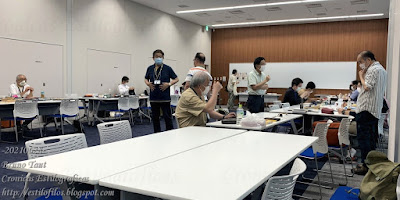The company Teranishi Chemical Industry has released a line of four inks under the name ハイカラ, Haikara in Romaji, which could in turn be either “high color” or “high collar”, a term with some history in Japan.
 The advertisement brochure. Four inks: Gentle Green, Melancholic Blue, Modern Red, and Salon de Violet. Note also the ideograms 大正浪漫, Taishô Roman, on top of the katakana ハイカラ.
The advertisement brochure. Four inks: Gentle Green, Melancholic Blue, Modern Red, and Salon de Violet. Note also the ideograms 大正浪漫, Taishô Roman, on top of the katakana ハイカラ.
ハイカラ / Haikara, as derived from “high collar”, is a word coined in Japan in the Meiji era (1868-1912) to describe with scorn the mostly male fashion of dressing with Western clothes. The term, however, became more neutral once Western clothes became less of a novelty, and is used even nowadays to describe something nostalgically trendy. In the packaging of these inks we can also see the inscription 大正浪漫, Taishô Roman (Taishô Romance): a term use nowadays for a romantisized view of the Taishô period (1912-1926).
Anyway, these inks come in 40 ml inkwells at a price of JPY 1500, plus taxes. This means JPY 37.5 / ml, which is more expensive than Pilot's Iroshizuku inks (JPY 30 / ml for the 50 ml inkwells) but a lot less than Sailor's Ink Studio (JPY 60 / ml) and Shikiori (JPY 50 / ml) inks.
So, is this just another company trying to cash in on the ink bubble with some more attractive prices?
The low tech and the low cost involved in making inks is indeed an incentive to enter this activity as we have seen in recent years. And the company Teranishi Chemical Industry comes with good credentials.
Teranishi Chemical Industry was founded in 1919 in Osaka. In 1931 it started making fountain pen ink that eventually carried the brand name “Guitar” or “Guitar Mark”. However, the main product of the company is the oil-based marker “Magic Ink”, very popular in Japan, and the fountain pen ink disappeared from the Teranishi catalog at some point after the War.
Then, in 2021 Teranishi Chemical Industry has made this new ink named generically ハイカラ or Haikara, which could be “High Color” or “High Collar”, while mentioning the old in-house brand “Guitar” and speaking of "Taishô Roman"...
Can this ink be a success with so many names?
Anonymous 6-bu jumbo pen – Kobe Ginza Gold Sepia
Bruno Taut
September-October 2021
labels: tinta, Japón, mercado, Haikara
Bruno Taut
September-October 2021
labels: tinta, Japón, mercado, Haikara

























































